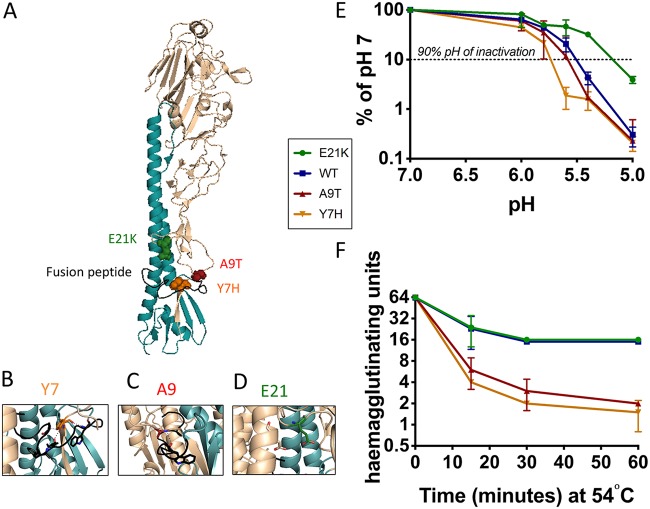FIG 1.
Generation of pH1N1 viruses with point mutations in the HA stalk that lead to altered acid and temperature stability. Three mutations predicted to alter HA pH stability were engineered into pH1N1 HA. (A) Residues in HA1 at positions 7, 9, and 21 (H1 numbering using mature HA sequence described by Burke and Smith [64]), located in close proximity to the fusion peptide (colored black), were selected. The location of mutations are modeled onto an HA monomer using the PyMOL molecular visualization tool (PDB ID 3LZG). (B) The hydroxyl group of tyrosine at position 7 in HA1 forms hydrogen bonds with the fusion peptide, which is predicted to destabilize HA when mutated to histidine (previously described in references 5 and 64). (C) The hydrophobic alanine residue at position 9 in HA1 interacts with W14 in the fusion peptide. Mutation to threonine is predicted to result in the destabilization of HA. A9T mutation was detected during cell culture passage experiments in our laboratory (A. Singanayagam and W. Barclay, unpublished data). (D) Residue 21 in HA1 is predicted to form a stabilizing intermonomer salt bridge with HA2 residue E47 when mutated from E to K (previously described in reference 42). (E) Virus was incubated in low-pH buffers for 15 min and the remaining infectious virus titrated by a plaque assay on MDCK cells. (F) Virus was incubated at 54°C for the indicated time and the remaining virus titrated by hemagglutination assay. (E and F) Data represent the mean ± standard deviation of triplicate experiments. Experiments are representative of at least two biological replicates.

